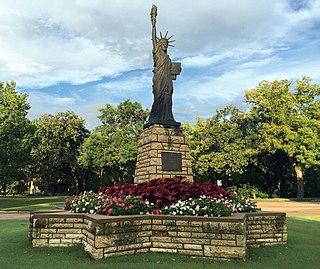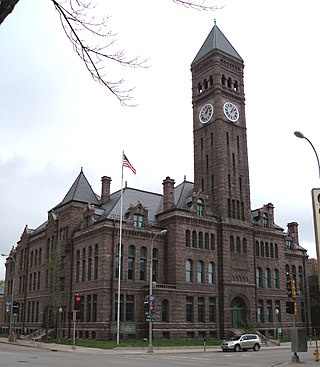
The Manhattan Building, also known as the Phoenix Building or the Phoenix-Manhattan Building, is a historic skyscraper in Muskogee, Oklahoma. The building has eight stories, containing 50,957 square feet (4,734.1 m2) of floor space, and was initially intended as the home of the Manhattan Construction Company, reportedly Oklahoma's first incorporated business. It was built in 1911 with a reinforced concrete frame and gray brick cladding. These walls were lined with windows to provide light and ventilation, the latter were essential to cope with torrid Oklahoma summers in an era when hardly any large buildings had air conditioning. It was built in Sullivanesque architectural style, with two-story columns flanking the entrance and a second floor cornice with dentils. The entry opened into a two-story lobby whose walls were covered with tile. A rooftop penthouse was added in 1957. The Manhattan Building was added to the National Register of Historic Places for architectural significance in 1983.

Strengthen the Arm of Liberty is the theme of the Boy Scouts of America's fortieth anniversary celebration in 1950. The campaign was inaugurated in 1949 with a dramatic ceremony held at the base of the Statue of Liberty. Approximately 200 BSA Statue of Liberty replicas were installed across the United States.

Charles Henry Owsley (1846–1935) was an English-born American architect in practice in Youngstown, Ohio, from 1872 until 1912.

George Richard Mann was an American architect, trained at MIT, whose designs included the Arkansas State Capitol. He was the leading architect in Arkansas from 1900 until 1930, and his designs were among the finalists in competitions for the capitols of several other states.
Patterson House, or Patterson Farmhouse or Patterson Farm may refer to:

Proudfoot & Bird was an American architectural firm that designed many buildings throughout the Midwest region of the United States. Originally established in 1882, it remains active through its several successors, and since 2017 has been known as BBS Architects | Engineers.

Link & Haire was a prolific architectural firm in Montana, formally established on January 1, 1906. It designed a number of buildings that are listed on the National Register of Historic Places.

Hawk & Parr was an American architectural firm active in Oklahoma City. It was formed in 1914 as the merger of the offices of architects J. W. Hawk and J. O. Parr. After the retirement of Hawk in 1932 and the death of Parr in 1940, it was led by Parr's son into the 1980s.

William F. Gernandt was a German-born architect who was based in Nebraska. He designed a number of courthouses and other buildings that are listed on the National Register of Historic Places.
Mann & Stern was an architectural partnership in Arkansas of Eugene John Stern (1884-1961) and George Richard Mann (1856-1939).

Wallace L. Dow (1844-1911), often known as W. L. Dow, was an architect of Sioux Falls, South Dakota. He has been referred to as the "Builder on the Prairie" and was "considered the premier architect of South Dakota in the late 19th century."

Thompson–Starrett Co. was an American construction contracting and engineering firm based in New York City that operated from 1899 until 1968.
The following is a timeline of the history of the city of Tulsa, Oklahoma, United States.

William N. Bowman was a prolific architect in Colorado.
Jewell Hicks was an architect in Oklahoma. He practiced on his own and at some point was a partner in Layton Hicks & Forsyth.

John P. Eisentraut (1870-1958) was an American architect most closely associated with South Dakota. Eisentraut designed a number of buildings, including Carnegie libraries and courthouses, several of which are listed on the National Register of Historic Places. He was one of South Dakota's leading architects during the first quarter of the twentieth century.

Erasmus T. Carr was an American architect in practice in Leavenworth, Kansas, Denver, Colorado and Miles City, Montana from 1857 until his retirement in 1898. Carr, along with John G. Haskell, was one of the first two professional architects to practice in Kansas.

Erhart & Eichenbaum, now known as GHN Architects & Engineers, is an American architectural firm. It was founded in Little Rock, Arkansas in 1930 by architects Frank J. Erhart and Howard S. Eichenbaum. The partnership was later expanded to include architects Noland Blass Jr., Lugean L. Chilcote, Jerry C. Wilcox and others. The firm was incorporated in 1980 and established a second office in Springfield, Missouri in 1981. In 2003 the two offices became independent, and only the Springfield office is still active. The firm was historically responsible for major works in and around Arkansas and is best known for the work completed by the founders and by Blass.

Wittenberg, Delony & Davidson is an American architectural firm. It was founded 105 years ago in 1919 in Little Rock, Arkansas as Wittenberg & Delony by architects George H. Wittenberg and Lawson L. Delony. Wittenberg's son, Gordon G. Wittenberg, assumed control of the firm in 1959 and under the leadership of him and his successor, Thomas A. Gray, the firm was well known for its high standards of design. The firm has since moved to North Little Rock and is active under the name WDD Architects.
















